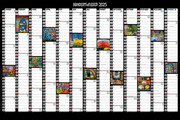Rebecca Warren (gebundenes Buch)
Rebecca Warren
Erschienen am
31.12.2012
Bibliographische Informationen
ISBN/EAN: 9783935567619
Sprache: Englisch
Seiten: 56 S., 50 Farbfotos
Fomat (h/b/t): 1.2 x 32.7 x 24.4 cm
Auflage: 1. Auflage 2012
Bindung: gebundenes Buch
Beschreibung
Im Mittelpunkt des Buchs steht eine Werkgruppe handbemalter Bronzeskulpturen, die Rebecca Warren 2012 geschaffen hat. Mit ihren rauen Oberflächen erinnern die langgewachsenen Figuren ein wenig an Giacomettis existenzielle Arbeiten. Auf den zweiten Blick aber vervielfältigen sich die Bezüge, wie Jörg Heiser in seinem Essay schreibt, der unter anderem Referenzen an Daisy Duck, Sigmund Freud und Amy Winehouse entdeckt. Auch der Genderdiskurs spielt eine wichtige Rolle und reicht bis in die maskulin oder feminin konnotierten Materialien und Arbeitstechniken. Um den vielfältigen Aspekten und der Allansichtigkeit des Werks gerecht zu werden, sind die Skulpturen im Buch nebeneinander von allen vier Seiten abgebildet, so dass jeder in die Form geknetete Fingerabdruck, jede farbliche Nuance der Bemalung im Detail sichtbar wird. Ein Triptychon von Vitrinenarbeiten mit Materialien aus dem Atelier der Künstlerin sowie einige Würfelskulpturen aus ungebranntem Ton, die wie leere, brüchige Sockel erscheinen, runden die Werkauswahl ab. BRONZE HEADS AND HAIR BOWS (Auszug aus dem Essay von Jörg Heiser) Rebecca Warren's recent series of seven sculptures are like stalagmites built not from minerals and salt, but from a plethora of archetypes, clichés and inventions, both ancient and contemporary, shaped into perplexing new form by the artist's hands. They have been sculpted in clay around a metal armature, then cast in bronze and hand-painted with car veneer to appear reminiscent of glazed ceramics. Roughly human-sized, their outline is slender and commanding at first (as well as a stalagmite, you might also think of a magnified tin soldier), yet some elements stick out like sore thumbs, or rather like bent elbows or bulbous noses or, in fact, like singular silicon breasts. The sculptures are placed on plinths, each coloured a different pastel hue, that are (purposefully and awkwardly) a little too modest and small to fulfil the plinth's classical role as guarantor of distinction and authority. Meanwhile, the sculptures themselves have undulating surfaces that feel at once amorphous (like the skin of a thickly magmatic brew) and haptic (shaped by the artist's hands, with imprints of the fingers' tips and the hand's gripping palm). With these qualities of shape and material all combined, these works make me think not only of stalagmites and tin soldiers, but also of Alberto Giacometti, Etruscan statues, Daisy Duck and Minnie Mouse, Giuseppe Arcimboldo, Sigmund Freud, Johann Wolfgang von Goethe, Amy Winehouse, Marisa Merz, Auguste Rodin and Medardo Rosso. Take, for example, "Toto" (2012), one of the seven slender sculptures. Apart from a large triangular element, reminiscent of Giacometti-esque sideways-pointing breasts, a big bulbous nose or a bent elbow, protruding from what could thus be read as the torso of the figure, there is also a hair bow stuck prominently on top of its (narrow, heavily contorted) 'head'. While the rest of the bronze is covered in hues of terracotta and cyan, the hair bow is blotched in old rose and pistachio, emphasizing the composite rather than unified aspect of the piece. The hair bow is a returning motif in Warren's work (see, for example, the voluptuous clay female figure Pony from 2003, which features a hair bow on top of its head like a boudoir pillow). It is a perfect shorthand code for cartoon female role models courtesy of Disney. Both Daisy Duck and Minnie Mouse sport huge hair bows that strongly differentiate them from their male hero counterparts Donald and Mickey. Warren pits these simplified cartoonist patterns of gender against the equally simplified, but pronouncedly 'serious' patterns that the male-dominated history of modernism has to offer. This experimental, slapstick collision of Giacometti and Disney, literally cast or pressed into one physical body, leaves neither unharmed. In fact Warren's sculpture could be read as a response to culturally entrenched gender tropes - the slender
Weitere Artikel aus der Kategorie "Kunst/Bildende Kunst"
Neuerscheinung

Neuerscheinung






